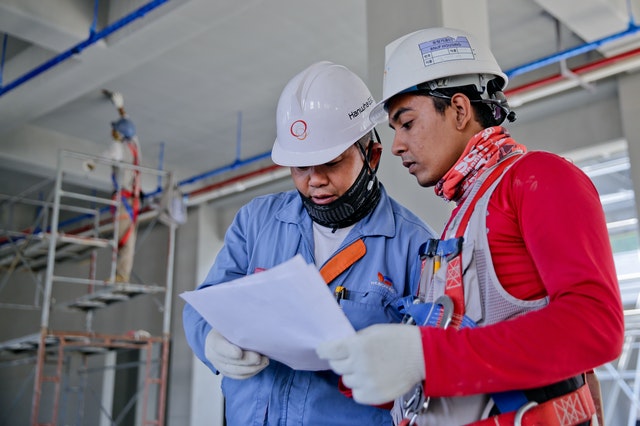You have probably heard that the best way to be a safety leader is by setting the right example. For some of you, this might sound repetitive. However, leading by example is certainly the most effective way to make workplace health and safety a collective effort within your workplace.
Frequently, our clients tell us that even though they are aware of the importance of getting everyone involved in their health and safety practices, they struggle with keeping workers motivated and empowered.
The struggle often happens because people follow what they see – both in action and in attitude. This is to say that your workers won’t commit to your safety culture, if you – as a manager or person of influence – are not seen to be committed yourself.
This is important. It is imperative that leaders first consider – then reconcile within themselves – why the safety of their people is important to them, rather than ‘doing’ safety simply to comply with the rules.
In this article we will explain three simple strategies that you can adopt to both develop and demonstrate your commitment to safety, and to guide your workforce to do the same.
1. Interact with people in their place of work
Communication is an essential tool for a safety leader. Not only does communication ensure expectations and responsibilities are shared and understood, it also provides an opportunity for management to understand what is working, and what is not.
Yet, when you limit the communication you have with your operative workforce to a weekly or monthly meeting of a maximum of one hour (for example, via safety meeting or committee) you may find that your workforce see safety as something that is additional to their work, rather than the way you work.
Communicating about safety outside of these meetings and, in fact, embedding communicating about safety throughout your entire operations can help to ensure that safety becomes part of the way you work.
Start interacting with people about safety outside of set meetings, and in the operational workplace settings in your organisation. Walk around your various work spaces, and chat with your workers.
Make safety an explicit part of your ‘walk-arounds’.
For this to be successful, you don’t need to formalise it. It does not need to be a documented inspection or an audit – this will occur at scheduled times. This is about walking throughout your operational facilities and watching people perform their everyday job, whilst you check in with them. As a safety leader, you’re trying to learn first if they have any safety concerns and also whether they are aware of their commitments and focus areas in safety.
The important thing is to keep this interaction open and less formal. Your workers should feel comfortable to raise their concerns and not feel as though they are being monitored for bad behaviour or not knowing something.
Don’t perform a safety walk-around without first considering:
- Be aware of your safety performance indicators. Play around in your Safety Management Software Reporting Module or your past reports. Analyse the key performance indicators (KPIs) such as which are the departments reporting the highest number of corrective actions, near misses or incidents.
- Review your safety compliance planning and inspection documentation. Be aware of which tasks and compliance activities are overdue.
- Ask the operations managers or team leaders if something is going on with regards to the health or personal life of one of their direct reports.
Having this information with you better prepares you to do your safety walk-around. You can address and/or anticipate conversations with workers. Additionally, you can properly respond in case you notice any unsafe practices that have led to an incident in the past, according to what you observed in your KPIs or what you had discussed with the team leader.
2. Have better safety conversations
As we said at the beginning of this article, a safety leader should lead by example. Therefore, think carefully about the quality of the conversations you are having around safety.
The kind conversations that take place during meetings or committees between you, safety professionals and workers will influence the conversations that are had between the front-line supervisors and the workers who report to them.
Be mindful that flippant or overly casual conversations may provide your workforce with insights as to whether you “truly” believe in your safety program. The trust you build in meetings can be instantly eroded with a flippant comment during Friday night drinks or any other time.
To make your conversations successful, you need to make sure that there is a two-way dialogue. You must give others, irrespective of their role in your organisation, the chance to express their opinions. They must also understand that you care about what they are saying.
To do so:
- Focus on the positive side of things. Often safety conversations only occur when something is not going well or a mistake has been made. Aim to change that pattern. Start acknowledging people’s achievements. When walking through your workplace, comment on the effective practices. When reflecting on your safety reporting and the performance of your established KPIs, identify which department or units are performing well, call it out, and congratulate them and their contribution.
- Be empathetic and curious. Workers don’t intentionally go out of their way to injure themselves and/or their team members. Unsafe actions or behaviours often occur because there is something else circumventing or driving their behaviour away from the established control. Having safety conversations with your workers, asking questions so that you can fully understand challenges they experience, and/or showing care and interest in their personal wellbeing is vital. This will help you to proactively manage hazards, and introduce change, before an incident occurs. Remember, if you ask the question, listen. If you are start off thinking that they are already wrong before you’ve heard them, seek to understand prior to making that judgement. Challenging their view might lose trust, but being open to listen helps. Importantly, identifying errors in your system, or identifying if someone is under stress, at the workplace can save lives as well.
- Don’t blame anyone. Instead, help people to realise their improvement opportunities. When starting a safety conversation it is important that the workers involved are given the opportunity to explain the reasoning behind their actions, rather than being directly criticised or blamed. This remains true even if it is directly after identifying an unsafe behaviour during a walk-around or incident investigation. It can be challenging at first. However, you are more likely to identify the root cause of the behaviour, allowing you to effectively address is. Additionally, if you want your workers to trust that you care about their safety and well-being, show them your support.
3. Do what you say as a Safety Leader
As a leader of your organisation, people are always watching you. So, be faithful to your safety message, in even the simplest ways.
This is not to say that you cannot make mistakes. However, you need to be careful that you are setting a good example regarding your safety commitment. This includes some of the more ‘basic’ aspects, such as wearing the proper personal protective equipment (PPE) during your walk-around, following the safety and health procedures when entering restricted areas and, ‘saying something if you see something’.
Avoid the trap of thinking that you don’t need to follow the processes and protocols that have been set – that they are for the team. This is a common error that leaders often make. And it’s one that usually results in poor safety management practices overall, and the perception of poor leadership.
Remember the saying: What is important to my manager is important to me.
If workers see that you ignore the safety processes that are in place, why would you expect them to see their value and take them seriously?
Finally, remember that leadership is service and there is no safety without service. In other words, as a safety leader who is aware of the broader organisational health and safety goals, you can use your strengths, knowledge and position to support and encourage others towards these shared goals. The best way to demonstrate your commitment is by leading by example to help others to become safety champions.
Need help or advice? Get in touch with us.

